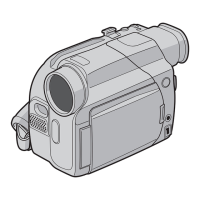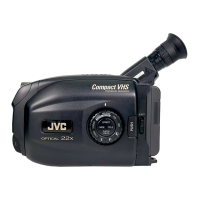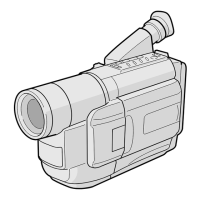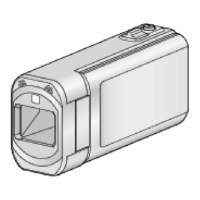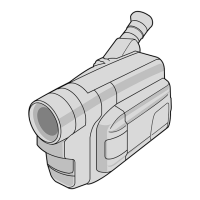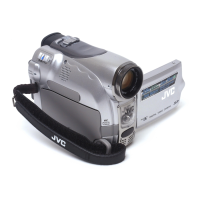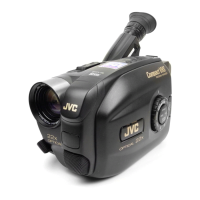SUPPLEMENTAL INFORMATION
What
is
"color
temperature"?
Light
is
composed
of
various
color
components
in
different
proportions.
A relationship exists
be-
tween
the
temperature
of
a
light
source and the
color
components
of
the
emitted
light
;
as
the
temperature rises,
the
color
of
the
I ight varies
from
red, orange,
yellow,
white
to
blue in
that
order.
"Color
temperature"
is
a value
that
ex-
presses
differences in
color
among
light
sources,
measured in Kelvin degrees. Bluish
light
has
a
higher
color
temperature than reddish light.
What
is
"white
balance"?
Making the colors
look
natural
on
TV
is
what
white
balance
is
all
about.
Because a camera
is
not
as
adaptable
as
the
human eye,
if
a
light
source
is
reddish,
white
subjects in
that
I ight
are
recorded
as
reddish. White balance adjustment
is
performed
to
compensate
for
color
tempera-
ture
variations
of
l
ight
so
that
wh
ites are repro-
duced
as
white.
Correct
white
balance makes all
other
colo
rs
correct. The G R-A30U can
perform
automatic
white
balance adjustment.
Ho
wever,
if
i
llumination
is
insu
fficient,
white
balance
ad-
justment
cannot
be
performed.
To
obtain
cor-
rect colors, therefore,
sufficient
illumination
is
essential.
What
is
"illuminance"?
"llluminance"
(also called
'luminance')
is
the
intensity
or
brightness
of
light, expressed in
lux
or
foot-candles
(fc).
The G R-
A30U
is designed
to
provide best pictures under the
conditions
of
a
700
-
lux
(67
fc)
illuminance
, although shooting
is
possible all the away
down
to
8
lux
(0.8 fc).
To
obtain
good pictures in very
bright
light, the
use
of
an
ND
(neutral density)
filter
is
recom-
mended.
(See
chart
on
this
page.)
How
to get good color pictures
The simplest way
is
to
provide
sufficient
I ight-
i
ng
(close
to
th
e camera's reference illuminance)
and
ac
c
urately
adjust
the
camera
to
the
color
temperature
of
that
lighting.
If
light
sources
of
d
iff
erent
color
tempe
ratures are used together,
accurate
white
balance adjustment
is
very
dif
-
fi
cult
.
For
exampl
e,
if
natural
light
is
mixed
w
ith
artificia
l
light
,
which
is
like
ly
to
occur
next
to
windows, correct colors
of
the
su
bje
ct
are
difficult
to
obta
in.
It
is
recommended in
such
cases
that
curtains in
th
e
room
be
closed
to
shut
out
light
from
outside. Also, when
artif
icial lighting devices are used,
they
should
all have
the
same
color
temp
erature. For exam-
ple,
it
is
recommended
that
incandescent
or
halogen lamps
not
be
us
ed toge
th
er
with
fluo
-
rescent I ighting.
Color temperatures
of
various artificial lighting
Type
of
illumination
Color
temperature
Tungsten
lamp
for
home
use
2800
K
Tungsten
lamp
for
photograph
ic use
Quartz-halogen
lamp
3200
K
Blue
lamp
for
photograph
ic use
5000
K
Warm
white
3500
K
Fluorescent
lamp
White
4500
K
Day I ight
type
6500
K
llluminance chart
•The
values
on
this
chart
are
approximated
to
give
you
a
rough reference.
'O
Unit
:
Lux
(fc)
~
·
;;;
Ql
'O
~
100,000-
•C
lear
sky,
mid-Oay,
under
sunl
ight
;;::
(9,
300)
(1
00,000/
9,300)
0
z
•C
lear sky
(10:00
a.m.)
unde
r sun
light
-
(
65
,
000
/
6,045)
• Cl
ea
r sky
(3:00
p.m
.)
unde
r sunl
ight
(35,
00
0/
3,255)
•C
l
oudy
sky
(mid-Oay)
under
sunlight
(3
2,000/2
,976)
~
•C
l
ou
dy
sky
(10:00
a.m.)
unde
r
sunlight
:i
iii
(
25
,
000
/2,
325)
u
10,000-
·
~
u
(930
)
"'
c.
~
•B
y t he w
indow
during
the
aft
ernoon
.E
(3,
500
/
324)
Ql
Cl
c
"'
2,
000
(
190
)- • Cl
oudy
s
ky
(on
e
hou
r
af
te
r sunrise)
a:
(2
,0
00
/1
90)
1,
000(94)-
•C
lear
sky
(one
hour
befo
re sunset)
(1 ,0
00
/9
4)
600(55)-
•Co
unter
s
at
department
st
or
es
(
500
-
700
/
47
-
66)
-
500(47)-
•Bowli
ng
center
(500
/47)
•Offic
e
under
flu
or
es
cent
light
(400
-
500
/
37
- 4 7)
•Lib
rary
(400
-
500
/
37
-
47
)
•D
ir
ect
li
ght
of
a
flashlight
at
1 m (3
ft
)
distance
(
250
/22.7)
'O
100(9)-
•St
ree
tl
ights
at
night
~
(150
-
200
/
13.5
-
18
)
·
;;;
Ql
80(7
.3
)-
'O
Cl
c
Mi
n
imum
.c
light ing
for
Cl
:.J
an o
bj
e
ct
15
(
1.4)-
• Cig
ar
ette
lighte
r
(at a dista nce of
30
cm/
11
.8
in)
(15
/
1.4)
10(1)-
•Candlelight
(at a
distan
ce
of
20 cm
/7
.9
i
n)
(
10
-
15
/ 1 -
1.4)
24
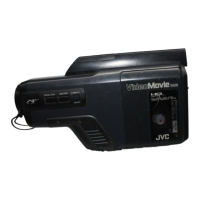
